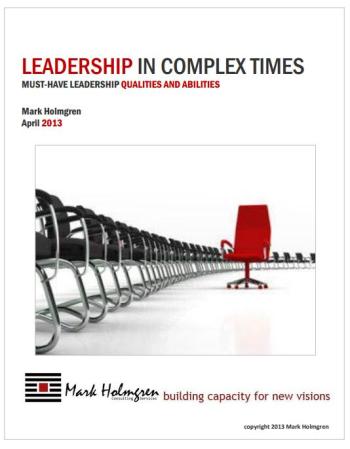Announcing the Release of
Leadership in Complex Times:
Must-Have Leadership Qualities and Abilities
Introduction
I have been working on this long essay for a year now on and off, and while I am never quite sure if I am done, I figure it is well enough along the way to share by now. I hope that it is helpful to you as a leader or aspiring leader in our sector. I am also interested in your feedback and comments. If you are interested in being a part of a discussion group about leadership, let me know. I am thinking of organizing one. Email me at [email protected]. Excerpts from the essay are below.
DOWN LOAD
LEADERSHIP IN COMPLEX TIMES
Excerpts
Do we truly envision a multicultural society? Do we really stand on common ground about what that even means? And who is the “we” doing the envisioning? Do immigrants come to Canada because they pine for being part of a cultural mosaic?
There is interest expressed across the funding community of forming long-term partnerships with those organizations that can produce results, and yet too many funders fail to offer long-term funding arrangements.The desire for partnerships is often thwarted by archaic funding mechanisms. For example, what are the prospects for sustaining authentic partnerships focused on having long-term impact when each year funders put out request for proposals?
There is another related trend we need to pay attention to which is the dissipating line that divides non-profit and private sector work to do social good. This is not just about both sectors engaging in social enterprise; it’s about how society is broadening its perspective on how social good should be delivered.The support from citizens for positive social impact will no longer be primarily focused on donations but also where they choose to spend their consumer dollars.
All of us want economic growth and prosperity but to what extent do we really evaluate who benefits from such largesse? To what extent is society – and all its various sectors and sub-sectors – willing and ready to tackle wicked questions?When it comes to poverty, are we asking ourselves questions that go beyond how we can help the poor? Do we have the courage to ask as well who benefits from poverty? Who thrives at the expense of low wages?
Leading an organization to a “changed state” is actually about helping people change fundamental aspects of who they are at work far more than what they might do differently. This may not be that much of a challenge if incremental or small change is the goal; however, bigger change – either major reform or transformation – cannot take place without personal reform or transformation.
 People who are certain they are right and others wrong, who believe there is just one way to do something, and who operate within the mythology of neat and tidy solutions will not only be hard pressed to be leaders, but will have a hard time finding meaning in their work.
People who are certain they are right and others wrong, who believe there is just one way to do something, and who operate within the mythology of neat and tidy solutions will not only be hard pressed to be leaders, but will have a hard time finding meaning in their work.
A high tolerance for ambiguity implies the ability to venture into areas of thought and possibility without having to know exactly what direction to take or where the destination actually is that you hope to find.It means accepting that you might end up in a place totally foreign to you and your current abilities.
A leader who is tolerant of ambiguity is, in effect, more than tolerant of it; he or she accepts ambiguity as a given, as a constant companion, and instead of attempting to view things through a mythological lens of clarity works with uncertainty, goes with the flow, and by doing builds and nurtures resiliency.
Leaders point to things and ask questions. Why do we do that? Why don’t we do that? They serve as catalysts for discovery and understand that there is typically no one right choice, but rather many choices to consider and many ways to get the organization to where it needs to get to.
 Organizations need their leaders to be cultural artists who help foster opportunities for people to change their work, change their minds, and change not only what the work is, but why they do it.
Organizations need their leaders to be cultural artists who help foster opportunities for people to change their work, change their minds, and change not only what the work is, but why they do it.
What we discover all too often becomes what confines us and stops us from future discovery. Even though we know there is no one solution, no single right way, we still seek such certainty. Leaders in complex times know certainty is over-rated.
Personal change is key to organizational change or transformation. Unfortunately, change management tends to focus on the group dynamics of change while ignoring how each person’s intellectual and emotional make-up as well as personal history and aspirations can make or break an organization’s journey to a new state.
Click HERE to download the essay. Please feel free to share it with others.





